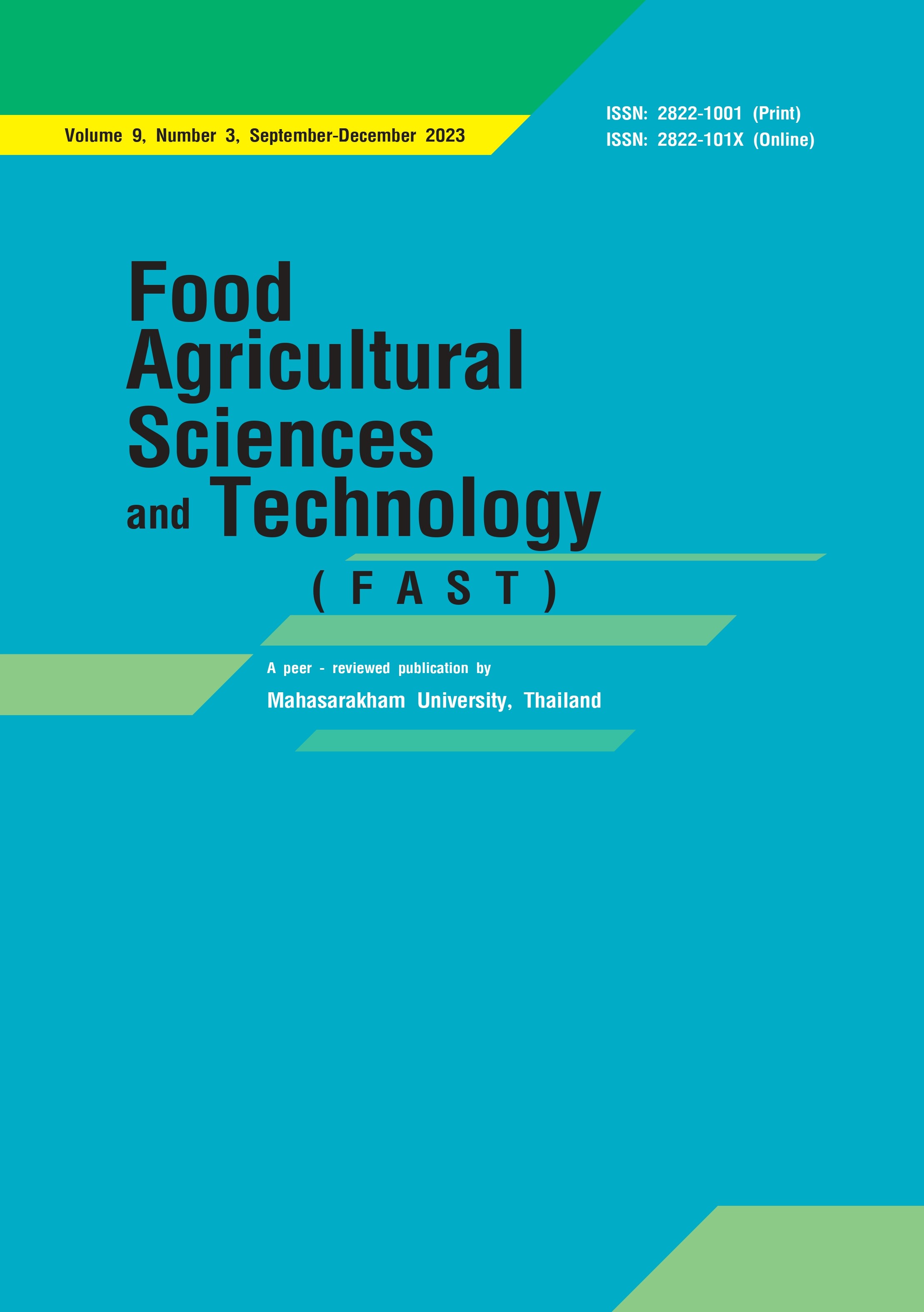Determine the color change of fresh green lettuce by using reflectance reconstruction from RGB image
Keywords:
Lettuce, image processing, reconstruction, color changeAbstract
This paper presents an image processing technique to determine the color change of salad lettuce is stored at 15ºC for storage times of 0 to 5 days. The technique divided the color of salad lettuce into 8 clusters (Dark-green, Light-green, Green-yellow, Brown, Dark, White, Shadow, and background) and used these clusters for spatial and spectral analysis. In the case of spatial analysis, the number of pixels of each cluster was countering over storage time for calculating the area of each cluster in the image and was used to determine the color change of the lettuce salad. In cases of spectral analysis, the reflectance reconstruction technique was applied to reconstruct the reflectance data from the image. RGB values from these images were transformed to tri-stimulus values (XYZ) and L*a*b* and then used with a trust-region-dogleg algorithm for reconstruction the reflectance from L*a*b* values. The reflectance data were normalized by an average sum of reflectance and called relative reflectance, and then use in the partial relative reflectance in a range of blue (450-500 nm), green (500-570 nm), and red (610-650 nm) to calculate the spectral gradient. The spectral gradient was used to determine the color change of the lettuce salad over storage. The result of both spatial and spectral analysis shows that changes in the colors of lettuce can be detected at storage time in days 3.
References
Aekrum, S., & Lertsiriyothin, W. (2015). Evaluation of quality changes of green oak salad using image texture analysis. Agricultural Science Journal, 46(Suppl.), 421-424.
Berwick, D., & Lee S.W. (2004). Spectral gradients for color-based object recognition and indexing. Computer Vision and Image Understanding, 7(1-3), 28-43.
Blasco, J., Aleixos, N., Cubero, S., Juste, F., Gómez-Sanchís, J., Alegre, V., & Moltó, E. (2009). Computer vision developments for the automatic inspection of fresh and processed fruits. Image Analysis for Agricultural Processes and Products, 21-34.
Blasco, J., Cubero, S., Arias, R., Gómez, J., Juste, F., Moltó, E. (2007). Development of a Computer Vision System for the Automatic Quality Grading of Mandarin Segments. In J. Martí, J.M. Benedí, A.M. Mendonça, & J. Serrat (eds), Pattern Recognition and Image Analysis (pp. 460-466). Springer.
Brosnan, T., & Sun, D.W. (2004). Improving quality inspection of food products by computer vision. Food Engineering Reviews, 61(1), 3-16.
Dejana, J., Tim, J., & Andrej, J. (2015). Comparison of two digital cameras based on spectral data estimation obtained with two methods. Acta Polytechnica Hungarica, 12(7), 183-197.
Du, C., & Sun, D.W. (2004). Recent developments in the applications of image processing techniques for food quality evaluation. Trends in Food Science & Technology, 15, 230-249.
Ferrante, A., Vernieri, P., Serra, G., & Tognoni, F. (2004). Changes in abscisic acid during leaf yellowing of cut stock flowers. Plant Growth Regulation, 43, 127-134.
Gardner, J. L. (2007). Comparison of calibration methods for tristimulus colorimeters. Journal of Research of the National Institute of Standards and Technology, 112(3), 129 -138.
Gnanasekharan,V., Shewfelt, R. L., & Chinnan M.S. (1992). Detection of color changes in green vegetables. Journal of Food Science, 57(1), 149-154.
Gutiérrez-Pulido, H., & Salazar, R.D.L.V. (2004). Análisisy diseo de experimeñtos. McGraw-Hill. Kader, A. A. (2013). Postharvest technology of horticultural crops-An overview from farm to fork. Ethiopian Journal of Applied Science and Technology, 1(1), 1-8.
León, K., Mery, D., Pedreschi, F., & León, J. (2006). Color measurement in L*a*b* units from RGB digital images. Food Research International, 39, 1084-1091.
Lu, F.; Bu, Z. & Lu, S. (2019). Estimating chlorophyll content of leafy green vegetables from adaxial and abaxial reflectance. Sensor, 19, 4059.
Lunadei, L., Diezma, B., & Lleó, L. (2012). Monitoring of fresh-cut spinach leaves through a multispectral vision system. Postharvest Biology and Technology, 63, 74-84.
Martinez, L.M (2021). True colors: Consumers’ packaging choices depend on the color of retail environment. Journal of Retailing and Consumer Services, 59, 102372.
Mendoza, F., & Aguilera, J.M. (2004). Application of image analysis for classification of ripening bananas. Journal of Food Science, 69(9), 471-477.
Pedreschi, F., Leo´n, J., Mery, D., & Moyano, P. (2004). Development of a computer vision system to measure the color of potato chips. Food Research International, 39, 1092-1098.
Poynton, C. A. (1996). A technical introduction to digital video. Wiley. Saldaña, E. (2013). Review: computer vision applied to the inspection and quality control of fruits and vegetables. Campinas, 16(4), 254-172.
U.S. Department of Agriculture. (2020). Statistics by subject national statistics for lettuce. https://www. nass.usda.gov /Statistics_bySubject
U.S. Department of Agriculture. (2019). Food availability (per capita) data system. Vegetable (fresh). 21 May 2020.. 2019. https://www.ers. usda.gov/data-products/ foodavailability-per-capita-datasystem.
Zhang, X., & Xu, H. (2009). An adaptively spatial color gamut mapping algorithm. Chinese Optics Letters, 7(09), 873-877.
Zhou, T., Harrison, A.D., & McKellar, R. (2004). Determination of acceptability and shelf life of ready-to-use lettuce by digital image analysis. Food Research International, 37, 875-881.
Downloads
Published
How to Cite
Issue
Section
License
Copyright (c) 2023 Food Agricultural Sciences and Technology

This work is licensed under a Creative Commons Attribution-NoDerivatives 4.0 International License.








